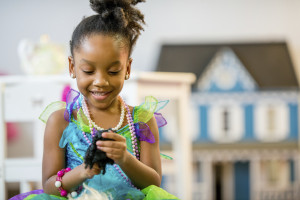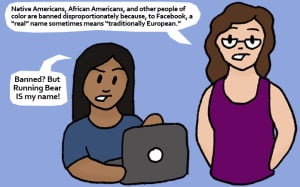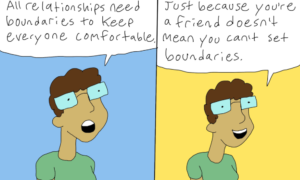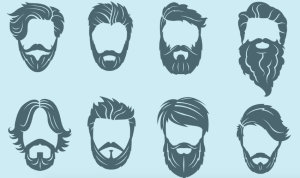The other day my six-year-old son, Rocco, told me he wanted a haircut. This is a kid who consistently puts his clothes on backwards, walks around with schmutz on his face, and who has never seemed to care about his appearance one bit.
So when he told me he wanted to lop off his shaggy mop, I was surprised and asked him why.
“My hair’s too long for a boy,” he told me.
Uh oh, I thought. And so it begins…
On the one hand, the fact that it had taken this long for my son to make that sort of comment made me feel like something was going right. On the other hand, I felt like, He’s only six, I sure wish he didn’t worry about this stuff yet!
But a lot of kids do worry about this stuff, and often from a really early age.
That’s true for those whose families actively reinforce gender norms, it’s true for those whose families don’t give it much thought, and it is also true for those whose parents try to dismantle the biased messages about masculinity and femininity that assault our kids on a daily basis.
And one of the places that assault is felt acutely is in regards to what is and is not deemed appropriate for someone to look like based on how their gender is read.
As a result, a lot of kids make statements about boys’ and girls’ appearances and bodies that can seem troublingly archaic.
So how do we respond when we hear our kids making such comments about themselves or others? What can we do when we see that gender bias is leading to disordered views on eating or exercise? And is there any way to prevent children from buying into harmful gender biases when those biases are are reinforced regularly by everyone from parents to peers, teachers to TV characters?
There may not be one perfect answer to those questions, but there are definitely ways we can begin to tackle them!
Here are four.
1. Understand the Gender-Biased Messages Kids Get Everyday
Like almost everyone else in society, kids and teens are hit with a daily onslaught of gendered messages about what they should look like.
Girls and children assigned female at birth learn that they are supposed to be thin, wear makeup, dress in a way that shows their bodies (but only to some completely hard to define degree), and that they will be rewarded for looking feminine.
In many circles, girls also understand that they are expected to put their appearances down. As Susan Greenhalgh explains in her recent book, Fat-Talk Nation: The Human Costs of America’s War on Fat, there is social pressure for girls to disparage their bodies through “fat talk” (like “Oh my God, I feel so fat today” or “I can’t wear skinny jean because I have such a big butt”), and it’s increasingly socially acceptable for girls to be obsessed with their bodies and with being thin.
Boys and children assigned male at birth, on the other hand, get the message that to really establish their position as a hetero male in society they need to exhibit physical strength and appear dominant over others.
So what does that look like?
According to the Encyclopedia of Body Image and Human Appearance, “In media, popular culture and sports, muscular, lean men often convey messages associated with masculinity, such as power, control, and strength.”
Boys also learn that men gain social status by having conventionally attractive and thin female partners, and girls learn that being one of these desired partners should be their ultimate goal.
Those messages are complicated enough for us as adults to deal with and many people struggle with how to reconcile how we feel about our desire to live up to such expectations while simultaneously critiquing the messages they represent. Now just imagine how much more complicated and confusing such messages are for children and teens!
2. Be a Role Model
Though I regularly point out gender stereotypes, or use examples of gender nonconformity when talking with my kids, as a cis woman who exhibits gender in a lot of traditional ways, I worry that I can sound inauthentic when I encourage my kids to question their gendered views about what is and isn’t appropriate for boys and for girls.
And while I sometimes wonder if I would be a better role model if I stopped shaving my legs or developed an interest in, say, auto mechanics, I also try to remind myself just because I don’t look like I challenge gender conventions doesn’t mean I am the wrong person to do so.
Rather, it means I just have to work at it a little more consistently, and I have to be ready to explain to my kids why, for example, my daughter should never feel like she has to wear heels or makeup, even if I often choose to.
And really, opening the door to a wider understanding of gender expression in children isn’t as hard as we sometimes think.
That was a fact I was reminded of after spending a recent morning at my friend Lana’s place.
Lana’s daughter was at camp, and her four-year-old son was at home playing. His game of choice? Disney princess. When I got there, he had already set up figurines and had broken out a pile of princess costumes with their long shiny dresses, glittery tiaras and plastic heels. After trying on a million colorful combos, he moved on to fairy costumes, and then when that got old, it was time for toy musical instruments.
While he was playing, I asked Lana if she had any advice for parents who wanted to help their kids embrace less traditional gender roles. She said, “I can’t really take any credit. Milo is who he is. I mean, it would never occur to me or [my husband] not to let him play with what he wanted to play with.”
And when I’m shopping with the kids, if he and his sister both want a glittery butterfly t-shirt, I’m not going to tell him he has to pick something with trucks on it that he doesn’t like. But we’re not doing anything special.”
But that’s the thing, in our incredibly gendered world, as sad as it may seem, simply letting children make these choices without judgment can be a huge step in helping them realize that they don’t have to be bound by conventional expectations, and parents who do that are in fact doing something special and should get some credit.
3. Accept Our Kids for Who They Are
Much of our understanding of gender is socially and culturally constructed. So how do we separate this from our children’s natural gender expression and their personal interests?
Doing so isn’t always obvious or possible. But think of it this way: Just like you can’t make a trans or gender non-conforming kid cisgender by forcing them to wear clothing that they find oppressive (or make an agender child identify with a gender – period), we also can’t make girls who refuse to leave home with hair undone happily sport a crewcut, or boys who want to wrestle endlessly fall in love with knitting if it isn’t their thing.
Indeed, my older kids’ late father tried just that and failed.
When my daughter was a toddler, on the few occasions we ran out of hand me downs, he would deliberately shop in the “boys” section of clothing stores since he loved to dress her in things like a brown turtleneck covered in dump trucks, grey track pants with reinforced knees, or black dinosaur sneakers that were clearly designed with a little boy in mind. And he intentionally refused to correct people who misgendered her.
But soon enough, our daughter started gravitating towards the more traditionally feminine outfits in her closet, and it became clear that for reasons either social or psychological, what she wanted to wear seemed to fall in line with mainstream expectations on the matter.
Of course, there was a big difference between doing this with a little girl and doing this with a little boy, since boys’ clothing choices are policed so much more heavily for signs of gender transgressions than are girls.
And this was, of course, not the same as affirming the clothing choices of a gender non-conforming or agender kid. But in his own way, my late partner was trying to subvert what he saw as some pretty limiting expectations that the world was trying to put on his kid.
4. Respond When Your Child Makes an Uncomfortable Comment About Gender
While it is fine for kids to have stereotypically gendered interests, this is not the same as letting their mistaken ideas on gender go unchallenged.
Here are some things you might hear and a few ideas about how to respond. Obviously, you can tailor these to your specific situation and to your child’s age!
1. ‘She’s Really Strong for a Girl’
A quick answer: “I think she’s really strong for anyone! That was amazing how she did the monkey bars without stopping.”
A longer answer: “For a girl makes it sounds like most girls aren’t strong. But think about all the strong girls and women we know, like your babysitter who I’ve seen carry two tired kids home, or your teacher who can lift up all the furniture in your classroom and rearrange it, or grandma who swims everyday, or your cousin Madison who plays hockey.”
2. ‘I’m Not Wearing Those – Dress Shoes Are So Gay!’
A quick answer: “You know, saying that is insulting to gay people, like your uncle Bob.” Or “I’m sure you didn’t mean that those shoes are attracted to the same gender.”
A longer answer: “How would you feel if I used a characteristic of yours, like how you have ADHD, as an insult? Sometimes people say that things they think are girly are ‘gay.’ But since there is nothing wrong with being a girl, and nothing wrong with being gay, using the term in this way is just hurtful to a lot of people.
3. ‘I Hate Being Bigger Than All the Boys in My Class’
A quick answer: “I know it can feel uncomfortable to stand out. But when I see how you’ve grown, it reminds me of all the things you can do now that you didn’t used to be able to do.” Or “Can you think of 10 things that are good about being bigger?”
A longer answer: “A lot of the reasons that we think girls should be smaller than boys is because those are the images we see in the media. But just because it is rare to see a TV or movie couple where the woman is bigger than the man, doesn’t mean that it is weird or abnormal for girls to be bigger than boys! In fact, during puberty girls are typically bigger than boys since they often develop earlier. And after puberty a lot of girls and women are still going to have bigger bodies than a lot of boys and men.”
4. ‘Boys Are Better Athletes Than Girls’
A quick answer: “Actually, being athletic doesn’t have anything to do with being a boy or a girl. Some of it is just built into who we are, and a lot of it is practice.”
A longer answer: “There are tons of amazing female athletes, like all those Women’s World Cup soccer players, but we don’t hear about them as much as we hear about male athletes. It’s like at school how there is a lot of hype for the boys’ football games, but no mention of the girls field hockey finals even though the girls’ team wins every year. Girls are just as athletic as boys, they just don’t always get to be in the spotlight.”
Don’t expect to change a child’s gender bias with a few comments, but over time, regularly having their biases challenged will counter a lot of the negative messages that kids are getting from other people in their lives.
Why We Need to Respond to Kids When They Make Gender-Biased Comments
There are a lot of reasons you may want to call a kid out (in?) when they express gender bias. But a big one is that people who hold gendered views often suffer as a result!
Dr. Maria do Mar Pereira, the author of the book, Doing Gender in the Playground has found that reinforcing traditional gender expectations in kids and forcing them to constantly manage their everyday life in line with gender norms can lead to body image issue in girls, violence in boys, and stress and anxiety in both.
Additionally, she explains, “Trying to live up to these unreal ideas of masculinity and femininity leads to a range of problems; low self-esteem, bullying, physical and verbal violence, health problems and a tragic loss of potential in our young people.”
Another study found that college women who hold traditional views about gender roles in sexual relationships are more likely to have dysfunctional body image attitudes, greater dissatisfaction with their bodies, more body dysphoria and greater thin-ideal internalization than those who hold less traditional views.
So really, we are doing everyone a service by nipping gender bias in the bud.
***
Living in a patriarchal society that is deeply intertwined with a cis hetero standard means that traditional ideas of what men’s and women’s bodies “should” look like, and how they should be presented in the world, often go unquestioned.
As a result, it isn’t surprising that a lot of kids will have gender bias around appearance and body image. But calling out bias when you see it and making space for your kids to express themselves in a range of ways will go a long way towards challenging an oppressive culture.
And in a world where girls learn early on that if their appearance and their body conforms to a certain standard they will gain higher social status, and where boys learn that deviating from a very narrow way of presenting themselves will have their hetero sexual orientation called into question, addressing children’s gender bias around these issues is a crucial step to really making a change.
[do_widget id=’text-101′]
Ellen Kate is a Contributing Writer for Everyday Feminism. She’s a health educator, sometimes writer, and mom. She has worked at Manhattan’s Museum of Sex, developed sex education curricula in Mumbai, India, and run HIV prevention programs for at-risk teens in the South Bronx. Currently, Ellen runs a middle and high school health education program and teaches human sexuality at Brooklyn College. More of Ellen’s writing can be found here. Follow her on Twitter @ellenkatef.
Search our 3000+ articles!
Read our articles about:
Our online racial justice training
Used by hundreds of universities, non-profits, and businesses.
Click to learn more
Most Read Articles
- « Previous
- 1
- …
- 30
- 31
- 32




















